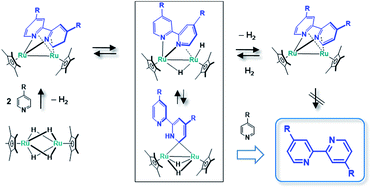Diruthenium complexes having a partially hydrogenated bipyridine ligand: plausible mechanism for the dehydrogenative coupling of pyridines at a diruthenium site†
Abstract
The reactions of the diruthenium tetrahydrido complex, Cp*Ru(μ-H)4RuCp* (1) (Cp* = η5-C5Me5), with pyridines were investigated in relation to the dehydrogenative coupling of 4-substituted pyridines. Complex 1 reacted with γ-picoline to yield the bis(μ-pyridyl) complex, {Cp*Ru(μ-H)(μ-4-MeC5H3)}2 (2a), with the elimination of dihydrogen. Complex 2a immediately reacted with the liberated dihydrogen to yield μ-η2-dihydrobipyridine (dhbpy) complex 4avia C–C bond formation between the two pyridyl groups, in which one of the pyridine rings underwent partial hydrogenation. The X-ray structure of 4a shows that the dhbpy moiety adopts a μ-η2 coordination mode at the Ru2 site. Complex 4a was reversibly converted to 5avia the elimination of dihydrogen in which the dhbpy moiety adopts a μ-η2:η2 mode. Although 5a was coordinatively saturated, 5a readily reacted with tBuNC to yield 6a. This was owing to the ability of the dhbpy ligand changing its coordination mode between the μ-η2:η2 and μ-η2 modes. This also causes the dehydrogenation from the dhbpy ligand to yield μ-η2:η2-bipyridine complex 7a at 140 °C. However, 7a was not shown to be an intermediate of the catalysis. The reaction of 1 with 1,10-phenanthroline afforded μ-η2-phenanthroline complex 8 containing two hydrides, which can be a model compound for the bipyridine elimination from the Ru2 site. Dynamic NMR studies suggested that 8 was isomerised to an unsaturated μ-N-heterocyclic carbene (NHC) complex. The unsaturated nature of the μ-NHC complex is likely responsible for the uptake of the third pyridine molecule to turn over the catalytic cycle.

- This article is part of the themed collection: Mechanistic processes in organometallic chemistry


 Please wait while we load your content...
Please wait while we load your content...